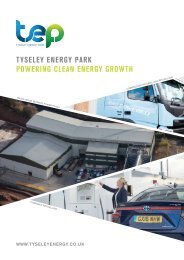connected-clusters-report-energy
Clustering innovation to create thriving and prosperous low-carbon cities and regions
Clustering innovation to create thriving and prosperous low-carbon cities and regions
You also want an ePaper? Increase the reach of your titles
YUMPU automatically turns print PDFs into web optimized ePapers that Google loves.
University of Birmingham | Climate-KIC 49<br />
Developing Markets for Climate Solutions<br />
Developing innovation alone is not a fruitful<br />
strategy unless there are customers for<br />
the products, services and knowledge that<br />
<strong>clusters</strong> have generated. Often, in the case<br />
of climate innovation <strong>clusters</strong>, green products<br />
and services present an alternative from<br />
the status quo and natural markets do not<br />
always exist. Climate innovation <strong>clusters</strong><br />
create value for their stakeholders by<br />
working together to create new markets<br />
for cleantech technologies.<br />
Examples of this can be found in Valencia,<br />
where AVAESEN convened meetings between<br />
city and regional governments aimed at<br />
showcasing the work of local innovators<br />
to those responsible for commissioning<br />
local works. By showcasing the potential<br />
advantage of new climate-friendly products<br />
and approaches and brokering relationships,<br />
a market for those products is created to<br />
supply the municipality.<br />
Sometimes, there are infrastructures that<br />
will enable certain types of climate innovation.<br />
For example, hydrogen fuelling stations for fuel<br />
cell vehicles; EV charging points for electric<br />
vehicles. Sometimes to enable the adoption<br />
of climate innovations, successful <strong>clusters</strong><br />
have focused on remedying the infrastructure<br />
barriers that prevent markets for new<br />
technologies from growing.<br />
In the Frankfurt study, we see the creation<br />
of hydrogen refuelling infrastructure,<br />
enabling the industrial hydrogen generated<br />
on site for chemical processes to be<br />
used as on-site low-carbon transport fuel.<br />
Similarly, in Birmingham the development<br />
of fuel cell refuelling facilities enabled a<br />
market for hydrogen transport solutions<br />
as part of the Energy Capital EIZ at Tyseley.<br />
Sometimes, it is about creating the foundations<br />
to enable infrastructure to work at scale.<br />
For example, the roadmap thinking going into<br />
the development of UK Central in the West<br />
Midlands will consider the effects on the local<br />
grid of a massive electro-mobility hub.<br />
Out of all the <strong>clusters</strong>, AVAESEN is currently<br />
placed in the most hostile regulatory<br />
environment. The fact that renewable<br />
<strong>energy</strong> not only doesn’t receive government<br />
support, but is actively discouraged from being<br />
included in the grid, meant that it was forced<br />
to diverge and innovate in order to survive.<br />
The divergence came in the form of broadening<br />
from <strong>energy</strong> to cleantech as well as helping<br />
internationalise some of its members.<br />
The innovation comes from its business<br />
support and think tank services. In terms of<br />
developing markets for climate solutions, the<br />
TAPs model has been effective in funding its<br />
efforts. One of the key services, aside from<br />
the ‘business as usual’ support, is access to<br />
networks which need climate solutions.<br />
The success of the TAPs model has led to<br />
the development of the SmartCities Think Tank,<br />
except this time the roles are reversed –<br />
rather than matching businesses to demand,<br />
demand (municipalities in this case) comes<br />
to the businesses.<br />
It is acknowledged that without having<br />
gained the support of businesses through<br />
the TAPs system, the reputation and goodwill<br />
would not have been there to institute the Think<br />
Tank model. AVAESEN is also an excellent<br />
example of how having in-house accelerator<br />
projects can help develop market solutions,<br />
as well as ensuring the cluster’s stability.<br />
The fact that businesses mature through<br />
the cluster means they are more likely to<br />
be happy to pay for the cluster’s services.<br />
Strengthening the breadth of businesses<br />
within the cluster means it is a more diverse<br />
and attractive partner, meaning it draws<br />
in more business for its members.<br />
Growing the ecosystem grows the<br />
market for climate solutions.<br />
The involvement of the GLA in Cleantech<br />
London means that policy has been very<br />
effectively used to develop markets for<br />
climate solutions. Both demand and supply<br />
are supported through regional policy<br />
in London. Demand is created by the need<br />
for London to meet its 2020 clean air targets,<br />
the stronger environmental regulations<br />
proposed in the Energy and Environment<br />
Strategy, and the desire for sustainable<br />
development in the 37 areas identified<br />
for redevelopment in the London Plan.<br />
Supply is supported by the Economic<br />
Development Strategy, which seeks<br />
to support cleantech businesses to<br />
reach market.




